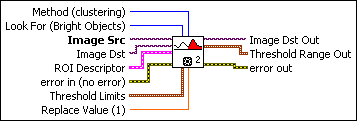IMAQ AutoBThreshold 2 VI
Installed With: NI Vision Development ModuleComputes the optimal threshold value for an image or a region of interest and applies the computed threshold.


 |
Look For (Bright Objects) indicates the type of objects for which you want to look. The following values are valid:
|
||||||||||||
 |
ROI Descriptor is a descriptor that defines the Region of Interest (ROI) within which the threshold is performed.
|
||||||||||||
 |
Image Src is a reference to the source image. |
||||||||||||
 |
Image Dst is a reference to the destination image. |
||||||||||||
 |
Method (clustering) specifies the threshold method to use. Choose from the following options:
|
||||||||||||
 |
error in (no error) describes the error status before this VI or function runs. The default is no error. If an error occurred before this VI or function runs, the VI or function passes the error in value to error out. This VI or function runs normally only if no error occurred before this VI or function runs. If an error occurs while this VI or function runs, it runs normally and sets its own error status in error out. Use the Simple Error Handler or General Error Handler VIs to display the description of the error code. Use error in and error out to check errors and to specify execution order by wiring error out from one node to error in of the next node.
|
||||||||||||
 |
Replace Value (1) specifies the replacement value the VI uses for the pixels of the kept objects in the destination image. |
||||||||||||
 |
Threshold Limits specifies the upper and lower bounds of the threshold values used to calculate the threshold.
|
||||||||||||
 |
Image Dst Out is a reference to the destination image. If Image Dst is connected, Image Dst Out is the same as Image Dst. Otherwise, Image Dst Out refers to the image referenced by Image Src. |
||||||||||||
 |
Threshold Range Out specifies the range used to threshold the image or ROI.
|
||||||||||||
 |
error out contains error information. If error in indicates that an error occurred before this VI or function ran, error out contains the same error information. Otherwise, it describes the error status that this VI or function produces. Right-click the error out indicator on the front panel and select Explain Error from the shortcut menu for more information about the error.
|









